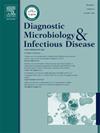Fluconazole-induced changes in azole resistance and biofilm production in Candida glabrata in vitro
IF 2.1
4区 医学
Q3 INFECTIOUS DISEASES
Diagnostic microbiology and infectious disease
Pub Date : 2025-01-09
DOI:10.1016/j.diagmicrobio.2025.116683
引用次数: 0
Abstract
Currently, the molecular mechanisms of azole resistance in C. glabrata are unresolved. This study aims to detect azole resistance of C. glabrata after exposure to fluconazole (Diflucan) in vitro. After 50 days of induction, the five susceptible isolates of C. glabrata demonstrated cross-resistance to azoles (fluconazole (Diflucan), voriconazole and itraconazole). Mutations in PDR1 or ERG11 genes are key nodes in azole resistance of C. glabrata. DNA-Sequencing revealed three(3/5) fluconazole (Diflucan)-resistant isolates had undergone missense mutations (R376Q, R772K, E1083K in PDR1 and F135L in ERG11), all of which were newly discovered and previously unreported. mRNA expression of resistant genes in five resistant isolated was elevated, with CDR1 being the most prominent. Analysis using flow cytometry revealed that resistant strains showed decreased R6G uptake and increased efflux efficiency, but no obvious significance difference in biofilm production. C. glabrata acquires azole cross-resistance upon continuous exposed to fluconazole (Diflucan) and could remain resistant without antifungal agents. The development of azole resistance in C. glabrata has been linked to genes associated with efflux pump transporters and the ergosterol synthesis pathway. However, the relationship between resistance and newly discovered missense mutation sites requires further investigation.
求助全文
约1分钟内获得全文
求助全文
来源期刊
CiteScore
5.30
自引率
3.40%
发文量
149
审稿时长
56 days
期刊介绍:
Diagnostic Microbiology and Infectious Disease keeps you informed of the latest developments in clinical microbiology and the diagnosis and treatment of infectious diseases. Packed with rigorously peer-reviewed articles and studies in bacteriology, immunology, immunoserology, infectious diseases, mycology, parasitology, and virology, the journal examines new procedures, unusual cases, controversial issues, and important new literature. Diagnostic Microbiology and Infectious Disease distinguished independent editorial board, consisting of experts from many medical specialties, ensures you extensive and authoritative coverage.

 求助内容:
求助内容: 应助结果提醒方式:
应助结果提醒方式:


